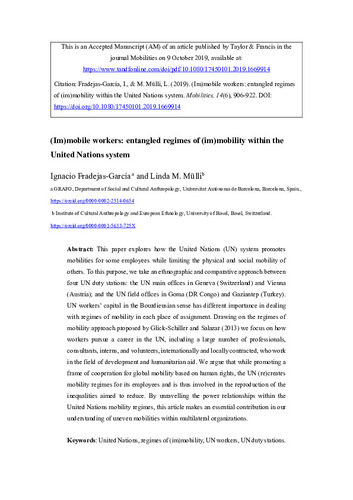(Im)mobile workers: entangled regimes of (im)mobility within the United Nations system
Autor(es) y otros:
Palabra(s) clave:
United Nations
Regimes of mobility
mobilities
UN workers
UN duty station
Fecha de publicación:
Editorial:
Taylor & Francis
Versión del editor:
Citación:
Descripción física:
Resumen:
This paper explores how the United Nations (UN) system promotes mobilities for some employees while limiting the physical and social mobility of others. To this purpose, we take an ethnographic and comparative approach between four UN duty stations: the UN main offices in Geneva (Switzerland) and Vienna (Austria); and the UN field offices in Goma (DR Congo) and Gaziantep (Turkey). UN workers’ capital in the Bourdieusian sense has different importance in dealing with regimes of mobility in each place of assignment. Drawing on the regimes of mobility approach proposed by Glick-Schiller and Salazar (2013) we focus on how workers pursue a career in the UN, including a large number of professionals, consultants, interns, and volunteers, internationally and locally contracted, who work in the field of development and humanitarian aid. We argue that while promoting a frame of cooperation for global mobility based on human rights, the UN (re)creates mobility regimes for its employees and is thus involved in the reproduction of the inequalities aimed to reduce. By unravelling the power relationships within the United Nations mobility regimes, this article makes an essential contribution in our understanding of uneven mobilities within multilateral organizations.
This paper explores how the United Nations (UN) system promotes mobilities for some employees while limiting the physical and social mobility of others. To this purpose, we take an ethnographic and comparative approach between four UN duty stations: the UN main offices in Geneva (Switzerland) and Vienna (Austria); and the UN field offices in Goma (DR Congo) and Gaziantep (Turkey). UN workers’ capital in the Bourdieusian sense has different importance in dealing with regimes of mobility in each place of assignment. Drawing on the regimes of mobility approach proposed by Glick-Schiller and Salazar (2013) we focus on how workers pursue a career in the UN, including a large number of professionals, consultants, interns, and volunteers, internationally and locally contracted, who work in the field of development and humanitarian aid. We argue that while promoting a frame of cooperation for global mobility based on human rights, the UN (re)creates mobility regimes for its employees and is thus involved in the reproduction of the inequalities aimed to reduce. By unravelling the power relationships within the United Nations mobility regimes, this article makes an essential contribution in our understanding of uneven mobilities within multilateral organizations.
Patrocinado por:
Swiss National Science Foundation (SNSF)
Colecciones
Ficheros en el ítem




